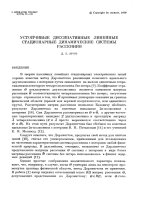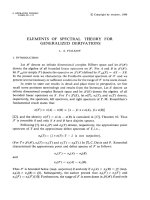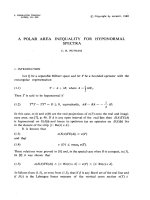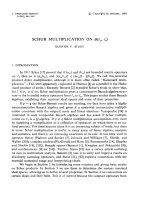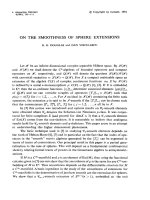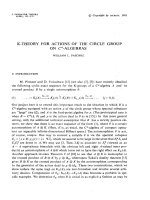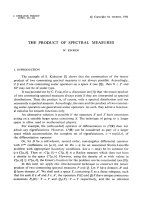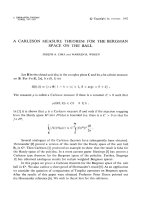Báo cáo toán học: "Skolem-type Difference Sets for Cycle Systems)" pot
Bạn đang xem bản rút gọn của tài liệu. Xem và tải ngay bản đầy đủ của tài liệu tại đây (115.14 KB, 12 trang )
Skolem-type Difference Sets for Cycle
Systems
Darryn Bryant
Department of Mathematics
University of Queensland
Qld 4072
Australia
Heather Gavlas
Department of Mathematics
Illinois State University
Campus Box 4520
Normal, IL 61790-4520
USA
Alan C. H. Ling
Department of Computer Science
University of Vermont
Burlington, Vermont 05405
USA
Submitted: May 24, 2002; Accepted: Sep 3, 2003; Published: Oct 6, 2003
MR Subject Classifications: 05C70, 05C38
Abstract
Cyclic m-cycle systems of order v are constructed for all m ≥ 3, and all v ≡
1(mod 2m). This result has been settled previously by several authors. In this
paper, we provide a different solution, as a consequence of a more general result,
which handles all cases using similar methods and which also allows us to prove
necessary and sufficient conditions for the existence of a cyclic m -cycle system of
K
v
− F for all m ≥ 3, and all v ≡ 2(mod 2m).
the electronic journal of combinatorics 10 (2003), #R38 1
1 Introduction
Throughout this paper, K
v
will denote the complete graph on v vertices and C
m
will
denote the m-cycle (v
1
,v
2
, ,v
m
). An m-cycle system of a graph G is a set C of m-cycles
in G whose edges partition the edge set of G. A survey on cycle systems is given in [12]
and necessary and sufficient conditions for the existence of an m-cycle system of G in the
cases G = K
v
and G = K
v
− F (the complete graph of order v with a 1-factor removed)
were given in [1, 15]. Such m-cycle systems exist if and only if v ≥ m, every vertex of G
has even degree, and m divides the number of edges in G.
Let ρ denote the permutation (0, 1, ,v − 1). An m-cycle system C of a graph G
with vertex set Z
v
is cyclic if for every m-cycle C =(v
1
,v
2
, ,v
m
)inC,them-cycle
ρ(C)=(ρ(v
1
),ρ(v
2
), ,ρ(v
m
)) is also in C.IfX is a set of m-cycles in a graph G with
vertex set Z
v
such that C = {ρ
α
(C) | C ∈ X, α =0, 1, ,v− 1} is an m-cycle system of
G,thenX is called a starter set for C,them-cycles in X are called starter cycles,andC
is said to be cyclically generated,orjustgenerated,bythem-cycles in X.
The existence question for cyclic m-cycle systems of complete graphs has attracted
much interest, and a complete answer for m = 3 [11], 5 and 7 [13] has been found. For m
even and v ≡ 1(mod 2m), cyclic m-cycle systems of K
v
are constructed for m ≡ 0(mod 4)
in [10] and for m ≡ 2(mod 4) in [13]. Both of these cases are also handled in [7]. For m
odd and v ≡ 1(mod 2m), cyclic m-cycle systems of K
v
are found using different methods
in [4, 3, 8], and, for v ≡ m(mod 2m) cyclic m-cycle systems of K
v
are given [5] for m ∈ M,
where M = {p
e
| p is prime, e>1}∪{15}, and in [18] for m ∈ M. Inthispaper,asa
consequence of a more general result, we find cyclic m-cycle systems of K
v
for all positive
integers m and v ≡ 1(mod 2m)withv ≥ m ≥ 4 using similar methods. We also settle the
existence question for cyclic m-cycle systems of K
v
− F for v ≡ 2(mod 2m).
For x ≡ 0(mod v), the modulo v length of an integer x, denoted |x|
v
, is defined to
be the smallest positive integer y such that x ≡ y(mod v)orx ≡−y(mod v). Note
that for any integer x ≡ 0(mod v), it follows that |x|
v
∈{1, 2, ,
v
2
}.IfL is a set
of modulo v lengths, we define L
v
to be the graph with vertex set Z
v
and edge set
{{i, j}||i − j|
v
∈ L}.ObservethatK
v
∼
=
{1, 2, ,v/2}
v
.Anedge{i, j} in a graph
with vertex set Z
v
is called an edge of length |i − j|
v
.
Let v>0 be an integer and suppose there exists an ordered m-tuple (d
1
,d
2
, ,d
m
)
satisfying each of the following:
(i) d
i
is an integer for i =1, 2, ,m;
(ii) | d
i
|
v
= |d
j
|
v
for 1 ≤ i<j≤ m;
(iii) d
1
+ d
2
+ + d
m
≡ 0(mod v); and
(iv) d
1
+ d
2
+ + d
r
≡ d
1
+ d
2
+ + d
s
(mod v) for 1 ≤ r<s≤ m.
Then (0,d
1
,d
1
+d
2
, ,d
1
+d
2
+ +d
m−1
) generates a cyclic m-cycle system of the graph
{|d
1
|
v
, |d
2
|
v
, ,|d
m
|
v
}
v
.Anm-tuple satisfying (i)-(iv) is called a modulo v difference
m-tuple,itcorresponds to the starter m-cycle {(0,d
1
,d
1
+ d
2
, ,d
1
+ d
2
+ + d
m−1
)},
the electronic journal of combinatorics 10 (2003), #R38 2
and it uses edges of lengths |d
1
|
v
, |d
2
|
v
, ,|d
m
|
v
.Amodulo vm-cycle difference set of
size t,oranm-cycle difference set of size t when the value of v is understood, is a set
consisting of t modulo v difference m-tuples that use edges of distinct lengths l
1
,l
2
, ,l
tm
;
the m-cycles corresponding to the difference m-tuples generate a cyclic m-cycle system C
of {l
1
,l
2
, ,l
tm
}
v
. Thus the modulo vm-cycle difference set generates C.
A Skolem sequence of order t is a sequence S =(s
1
,s
2
, ,s
2t
)of2t integers satisfying
the conditions
(S1) for every k ∈{1, 2, ,t} there exist exactly two elements s
i
,s
j
∈ S such that
s
i
= s
j
= k;
(S2) if s
i
= s
j
= k with i<j,thenj − i = k.
It is well-known that a Skolem sequence of order t exists if and only if t ≡ 0, 1(mod 4)
[17]. For t ≡ 2, 3(mod 4), the natural alternative is a hooked Skolem sequence. A hooked
Skolem sequence of order t is a sequence HS =(s
1
,s
2
, ,s
2t+1
)of2t+1 integers satisfying
conditions (S1) and (S2) above and
(S3) s
2t
=0.
It is well-known that a hooked Skolem sequence of order t exists if and only if t ≡
2, 3(mod 4) [9].
Skolem sequences and their generalisations have been used widely in the construction
of combinatorial designs, a survey on Skolem sequences can be found in [6], and perhaps
the most well-known use of Skolem sequences is in the construction of cyclic Steiner triple
systems. A Steiner triple system of order v is a pair (V,B)whereV is a v-set and B is a
set of 3-subsets, called triples, of V such that every 2-subset of V occurs in exactly one
triple of B. A Steiner triple system of order v is equivalent to a 3-cycle system of K
v
,anda
Skolem sequence S =(s
1
,s
2
, ,s
2t
) or a hooked Skolem sequence HS =(s
1
,s
2
, ,s
2t+1
)
of order t can be used to construct the 3-cycle difference set
{(k, t + i, −(t + j)) | k =1, 2, ,t, s
i
= s
j
= k, i < j}
of size t which generates a cyclic 3-cycle system of K
6t+1
(the m-tuple (k, 3t+1−k, −(3t+
1)) obtained from a hooked Skolem sequence of order t uses edges of lengths k,3t +1− k
and 3t).
Notice that if (d
1
,d
2
, ,d
m
) is a modulo v difference m-tuple with d
1
+d
2
+ +d
m
=
0, not just d
1
+ d
2
+ + d
m
≡ 0(mod v), then (d
1
,d
2
, ,d
m
) is a modulo w difference
m-tuple for all w ≥ M/2+1 where M = |d
1
| + |d
2
| + ···+ |d
m
|. All the difference triples
obtained from Skolem sequences and hooked Skolem sequences are of the form (d
1
,d
2
,d
3
)
with d
1
+ d
2
+ d
3
= 0. In the literature, difference triples obtained from Skolem sequences
are usually written (a, b, c)witha + b = c. However, the equivalent representation we
are using here, with c replaced by −c so that a + b + c = 0, is more convenient for the
purpose of extending these ideas to m-cycle systems with m>3. We make the following
definition.
the electronic journal of combinatorics 10 (2003), #R38 3
Definition 1.1 A difference m-tuple (d
1
,d
2
, ,d
m
)isofSkolem-type if d
1
+ d
2
+ +
d
m
=0. Anm-cycle difference set using edges of lengths 1, 2, ,mt, and in which all of
the m-tuples are of Skolem type, is called a Skolem-type m-cycle difference set of size t.
An m-cycle difference set using edges of lengths 1, 2, ,mt− 1,mt+ 1, and in which all
of the m-tuples are of Skolem type, is called a hooked Skolem-type m-cycle difference set
of size t.
Clearly, (hooked) Skolem sequences of order t yield (hooked) Skolem-type 3-cycle
difference sets of size t. In this paper, we prove necessary and sufficient conditions for
the existence of Skolem-type and hooked Skolem-type m-cycle difference sets of size t for
all m ≥ 3andallt ≥ 1 (see Theorem 2.3). As a corollary, we obtain several existence
results on cyclic m-cycle systems. These include necessary and sufficient conditions for
the existence of cyclic m-cycle systems of K
v
for all v ≡ 1(mod 2m)andK
v
− F for all
v ≡ 2(mod 2m).
As remarked earlier, several cases of these results have been settled previously. How-
ever, in this paper, we provide a complete solution in which all of the cases are dealt
with using similar methods. Moreover, since the difference sets are of Skolem-type, we
also obtain cyclic m-cycle systems of {1, 2, ,
v
2
}
w
or {1, 2, ,
v
2
− 1,
v
2
+1}
w
for
infinitely many values of w, which have not been previously found. All of our Skolem-
type m-cycle difference sets will have the additional property that the number of positive
integers in each m-tuple differs from the number of negative integers by at most one. In
other words, when m is even the number of positive integers equals the number of negative
integers, and when m is odd the number of positive integers and the number of negative
integers differ by one.
To construct our sets of Skolem-type difference tuples we will use Langford sequences.
A Langford sequence of order t and defect d is a sequence L =(
1
,
2
, ,
2t
)of2t integers
satisfying the conditions
(L1) for every k ∈{d, d +1, ,d+ t − 1} there exists exactly two elements
i
,
j
∈ L
such that
i
=
j
= k,and
(L2) if
i
=
j
= k with i<j,thenj − i = k.
A hooked Langford sequence of order t and defect d is a sequence L =(
1
,
2
, ,
2t+1
)of
2t + 1 integers satisfying conditions (L1) and (L2) above and
(L3)
2t
=0.
Clearly, a (hooked) Langford sequence with defect 1 is a (hooked) Skolem sequence. The
following theorem gives necessary and sufficient conditions for the existence of Langford
sequences.
Theorem 1.2 [16] There exists a Langford sequence of order t and defect d if and only
if
(1) t ≥ 2d − 1, and
the electronic journal of combinatorics 10 (2003), #R38 4
(2) t ≡ 0, 1(mod 4) and d is odd, or t ≡ 0, 3(mod 4) and d is even.
There exists a hooked Langford sequence of order t and defect d if and only if
(1) t(t − 2d +1)+2≥ 0, and
(2) t ≡ 2, 3(mod 4) and d is odd, or t ≡ 1, 2(mod 4) and d is even.
In a similar manner to which 3-cycle difference sets are constructed from Skolem and
hooked Skolem sequences, a Langford sequence or hooked Langford sequence of order
t can be used to construct a 3-cycle difference set of size t that uses edges of lengths
d, d +1,d+2, ,d+3t − 1ord, d +1,d+2, ,d+3t − 2,d+3t respectively.
2 Construction of Difference Sets for Cycle Systems
Before proving the main theorem, we need the following two lemmas which are used in
extending m-cycle difference sets of size t to (m +4)-cycle difference sets of size t. Lemma
2.1 is for ordinary Skolem-type m-cycle difference sets and Lemma 2.2 is for hooked
Skolem-type m-cycle difference sets.
Lemma 2.1 Let n, r and t be positive integers. There exists a t × 4r matrix Y (r, n, t)=
[y
i,j
] such that {|y
i,j
||1 ≤ i ≤ t, 1 ≤ j ≤ 4r} = {n +1,n+2, ,n+4rt}, the sum of the
entries in each row of Y (r, n, t) is zero, and |y
i,1
| < |y
i,2
| < <|y
i,4r
| for i =1, 2, ,t.
Proof.LetY
(r, n, t) be the matrix
2t − 12t 4t − 14t 4rt − 14rt
2t − 32t − 24t − 34t − 24rt − 34rt − 2
.
.
.
.
.
.
.
.
.
.
.
. ···
.
.
.
.
.
.
342t +3 2t +4 (4r − 2)t +3 (4r − 2)t +4
122t +1 2t +2 (4r − 2)t +1 (4r − 2)t +2
+
n ··· n
.
.
.
.
.
.
.
.
.
n ··· n
and let Y be the matrix obtained from Y
by multiplying by −1 each entry in column j
for all j ≡ 2, 3(mod 4). It is straightforward to verify that Y has the required properties.
Lemma 2.2 Let n, r and t be positive integers. There exists a t × 4r matrix Y (r, n, t)=
[y
i,j
] such that {|y
i,j
||1 ≤ i ≤ t, 1 ≤ j ≤ 4r} = {n, n+2,n+3, ,n+4rt−1,n+4rt+1},
the sum of the entries in each row is zero, and |y
i,1
| < |y
i,2
| < <|y
i,4r
| for i =1, 2, ,t.
Proof.LetY
(r, n, t) be the matrix
024t − 14t 4rt − 14rt +1
2t − 12t 4t − 34t − 24rt − 34rt − 2
.
.
.
.
.
.
.
.
.
.
.
. ···
.
.
.
.
.
.
562t +3 2t +4 (4r − 2)t +3 (4r − 2)t +4
342t +1 2t +2 (4r − 2)t +1 (4r − 2)t +2
+
n ··· n
.
.
.
.
.
.
.
.
.
n ··· n
the electronic journal of combinatorics 10 (2003), #R38 5
and let Y be the matrix obtained from Y
by multiplying by −1 each entry in column j
for all j ≡ 2, 3(mod 4). It is straightforward to verify that Y has the required properties.
We are now ready to prove necessary and sufficient conditions for the existence of
Skolem-type and hooked Skolem-type m-cycle difference sets of size t.
Theorem 2.3 Let m and t be integers with m ≥ 3 and t ≥ 1. There exists a Skolem-type
m-cycle difference set of size t if and only if mt ≡ 0, 3(mod 4). There exists a hooked
Skolem-type m-cycle difference set of size t if and only if mt ≡ 1, 2(mod 4).
Proof.Ifmt ≡ 1, 2(mod 4) and {|x
1
|, |x
2
|, ,|x
mt
|} = {1, 2, ,mt} then x
1
+x
2
+ +
x
mt
is odd, and it follows that there is no Skolem-type m-cycle difference set of size t.
Similarly, if mt ≡ 0, 3(mod 4) and {|x
1
|, |x
2
|, ,|x
mt
|} = {1, 2, ,mt− 1,mt+1} then
x
1
+ x
2
+ + x
mt
is odd, and it follows that there is no hooked Skolem-type m-cycle
difference set of size t. Hence it remains to construct a Skolem-type m-cycle difference
set of size t whenever mt ≡ 0, 3(mod 4) and a hooked Skolem-type m-cycle difference set
of size t whenever mt ≡ 1, 2(mod 4).
The proof splits into four cases depending on the congruence class of m modulo 4.
For each case we construct a t × m matrix X =[x
i,j
] with entries 1, 2, ,mt when
mt ≡ 0, 3(mod4)orwithentries1, 2, ,mt− 1,mt+1 when mt ≡ 1, 2(mod 4) such that
for each i =1, 2, ,t,wehave
m
j=1
x
i,j
=0.
The entries in each row of our matrices will also satisfy various inequalities which will
allow us to arrange them so that for 1 ≤ r<s≤ m and v ≥ 2mt +1, we have
d
1
+ d
2
+ ,d
r
≡ d
1
+ d
2
+ ,d
s
(mod v), so that a Skolem-type m-cycle difference set
of size t can be obtained.
Case 1. Suppose that m ≡ 0(mod 4). In this case, mt ≡ 0(mod 4) for all t and let
X =[x
i,j
]bethet × m matrix Y (
m
4
, 0,t) given by Lemma 2.1. For i =1, 2, ,t,we
have |x
i,1
| < |x
i,2
| < ···< |x
i,m
| and x
i,j
< 0 precisely when j ≡ 2, 3(mod 4). Hence the
required set of m-tuples can be constructed directly from the rows of X by including the
m-tuple
(x
i,1
,x
i,3
,x
i,5
,x
i,7
, ,x
i,m−3
,x
i,m−1
,x
i,m−2
,x
i,m−4
,x
i,m−6
, ,x
i,6
,x
i,4
,x
i,2
,x
i,m
)
for i =1, 2, ,t.
the electronic journal of combinatorics 10 (2003), #R38 6
Case 2. Suppose that m ≡ 2(mod 4). In this case, mt ≡ 0(mod 4) when t is even and
mt ≡ 2(mod 4) when t is odd. If t is even, let
X =
1 −23−4 −57
6 −810−9 −11 12
13 −14 15 −16 −17 19
18 −20 22 −21 −23 24
.
.
.
.
.
.
.
.
.
.
.
.
.
.
.
.
.
. Y (
m−6
4
, 6t, t)
6t − 12 −(6t − 10) 6t − 8 −(6t − 9) −(6t − 7) 6t − 6
6t − 5 −(6t − 4) 6t − 3 −(6t − 2) −(6t − 1) 6t +1
where Y (
m−6
4
, 6t, t)isthet ×
m−6
4
matrix given by Lemma 2.1, and if t is odd, let
X =
1 −23−4 −57
6 −810−9 −11 12
13 −14 15 −16 −17 19
18 −20 22 −21 −23 24
.
.
.
.
.
.
.
.
.
.
.
.
.
.
.
.
.
. Y (
m−6
4
, 6t, t)
6t − 11 −(6t − 10) 6t − 9 −(6t − 8) −(6t − 7) 6t − 5
6t − 6 −(6t − 4) 6t − 2 −(6t − 3) −(6t − 1) 6t
where Y (
m−6
4
, 6t, t)isthet ×
m−6
4
matrix given by Lemma 2.2. For i =1, 2, ,t,we
have |x
i,1
| < |x
i,2
| < |x
i,4
| < |x
i,5
| < |x
i,6
| < ···< |x
i,m
|, |x
i,2
| < |x
i,3
| < |x
i,5
|,andx
i,j
< 0
precisely when j =2andwhenj ≡ 0, 1(mod 4) with j ≥ 4. Hence, the required set of
m-tuples can be constructed directly from the rows of X by including the m-tuple
(x
i,1
,x
i,2
,x
i,3
,x
i,5
,x
i,7
,x
i,m−3
,x
i,m−1
,x
i,m−2
,x
i,m−4
,x
i,m−6
, ,x
i,6
,x
i,4
,x
i,m
).
for i =1, 2, ,t.
Case 3. Suppose that m ≡ 3(mod 4). In this case, mt ≡ 0, 3(mod 4) when t ≡ 0, 1(mod 4)
and mt ≡ 1, 2(mod 4) when t ≡ 2, 3(mod 4). If t ≡ 0, 1(mod 4), there exists a Skolem
sequence of order t,andlet{{a
i
,b
i
,c
i
}|1 ≤ i ≤ t} be a set of t difference triples using
edges of lengths {1, 2, ,3t} constructed from such a sequence. If t ≡ 2, 3(mod 4), there
exists a hooked Skolem sequence of order t,andlet{{a
i
,b
i
,c
i
}|1 ≤ i ≤ t} be a set of t
difference triples using edges of lengths {1, 2, ,3t − 1, 3t +1} constructed from such a
sequence. Furthermore, when t ≡ 2, 3(mod 4), we ensure that 3t +1∈ {a
1
,b
1
,c
1
}.Let
X =
a
1
c
1
b
1
a
2
c
2
b
2
.
.
.
.
.
.
.
.
. Y (
m−3
4
, 3t, t)
a
t
c
t
b
t
where Y (
m−3
4
, 3t, t)isthet ×
m−3
4
matrix given by Lemma 2.1 or 2.2 if t ≡ 0, 1(mod 4) or
t ≡ 2, 3(mod 4) respectively. For i =1, 2, ,t,wehave|x
i,1
| < |x
i,2
| < |x
i,4
| < |x
i,5
| <
the electronic journal of combinatorics 10 (2003), #R38 7
|x
i,6
| < ···< |x
i,m
|, |x
i,3
| < |x
i,5
|,andx
i,j
< 0 precisely when j ≥ 2andj ≡ 1, 2(mod 4).
Hence, the required set of m-tuples can be constructed directly from the rows of X by
including the m-tuple
(x
i,1
,x
i,2
,x
i,4
,x
i,6
,x
i,8
, ,x
i,m−3
,x
i,m−1
,x
i,m−2
,x
i,m−4
,x
i,m−6
, ,x
i,5
,x
i,3
,x
i,m
)
for i =1, 2, ,t.
Case 4. Suppose that m ≡ 1(mod 4). In this case, mt ≡ 0, 3(mod 4) when t ≡ 0, 3(mod 4)
and mt ≡ 1, 2(mod 4) when t ≡ 1, 2(mod 4). The matrix X is slightly different for each
of the four congruence classes of t modulo 4.
When t ≡ 0(mod 4), there exists a Langford sequence of order t − 1 and defect 2, and
let {{a
i
,b
i
,c
i
}|1 ≤ i ≤ t − 1} be a set of t − 1 difference triples using edges of lengths
2, 3, ,3t − 2 constructed from such a sequence. Let
X =
1 −23 5t − 2 −(5t)
a
1
+2 c
1
− 2 b
1
+2 5t − 6 −(5t − 4)
a
2
+2 c
2
− 2 b
2
+2 5t − 10 −(5t − 8)
.
.
.
.
.
.
3t +2 −(3t +4)
.
.
.
.
.
.
.
.
.5t − 3 −(5t − 1) Y (
m−5
4
, 5t, t)
5t − 7 −(5t − 5)
.
.
.
.
.
.
a
t−1
+2 c
t−1
− 2 b
t−1
+2 3t +1 −(3t +3)
where Y (
m−5
4
, 5t, t)isthet ×
m−5
4
matrix given by Lemma 2.1.
When t ≡ 3(mod 4), there exists a hooked Langford sequence of order t −1 and defect
2andlet{{a
i
,b
i
,c
i
}|1 ≤ i ≤ t − 1} be a set of t − 1 difference triples using edges of
lengths 2, 3, ,3t − 3, 3t − 1 constructed from such a sequence. Let
X =
a
1
+2 c
1
− 2 b
1
+2 5t − 3 −(5t − 1)
a
2
+2 c
2
− 2 b
2
+2 5t − 7 −(5t − 5)
.
.
.
.
.
.
3t +3 −(3t +5)
.
.
.
.
.
.
.
.
.5t − 2 −(5t) Y (
m−5
4
, 5t, t)
5t − 6 −(5t − 4)
.
.
.
.
.
.
a
t−1
+2 c
t−1
− 2 b
t−1
+2 3t +4 −(3t +6)
1 −23 3t −(3t +2)
where Y (
m−5
4
, 5t, t)isthet ×
m−5
4
matrix given by Lemma 2.1.
When t =1,letX =[1 − 234 − 6 Y (
m−5
4
, 5, 1)] where Y ((m − 5)/4, 5, 1) is the
1 ×
m−5
4
matrix given by Lemma 2.2. For t ≡ 1(mod 4), t ≥ 5, there exists a Langford
the electronic journal of combinatorics 10 (2003), #R38 8
sequence of order t − 1 and defect 2, and let {{a
i
,b
i
,c
i
}|1 ≤ i ≤ t − 1} be a set of t − 1
difference triples using edges of lengths 2, 3, ,3t − 2 constructed from such a sequence.
Let
X =
1 −23 5t − 1 −(5t +1)
a
1
+2 c
1
− 2 b
1
+2 5t − 4 −(5t − 2)
a
2
+2 c
2
− 2 b
2
+2 5t − 8 −(5t − 6)
.
.
.
.
.
.
3t +2 −(3t +4)
.
.
.
.
.
.
.
.
.5t − 5 −(5t − 3) Y (
m−5
4
, 5t, t
5t − 9 −(5t − 7)
.
.
.
.
.
.
a
t−1
+2 c
t−1
− 2 b
t−1
+2 3t +1 −(3t +3)
where Y (
m−5
4
, 5t, t)isthet ×
m−5
4
matrix given by Lemma 2.2.
When t =2,let
X =
1 −567 −9 Y (
m−5
4
, 10, 2)
2 −348−11
where Y (
m−5
4
, 10, 2) is the 2 ×
m−5
4
matrix given by Lemma 2.2. For t ≡ 2(mod 4),
t ≥ 6, there exists a hooked Langford sequence of order t − 1 and defect 2, and let
{{a
i
,b
i
,c
i
}|1 ≤ i ≤ t − 1} be a set of t − 1 difference triples using edges of lengths
2, 3, ,3t − 3, 3t − 1 constructed from such a sequence. Let
X =
a
1
+2 c
1
− 2 b
1
+2 5t − 1 −(5t +1)
a
2
+2 c
2
− 2 b
2
+2 5t − 5 −(5t − 3)
5t − 9 −(5t − 7)
.
.
.
.
.
.
3t +3 −(3t +5)
.
.
.
.
.
.
.
.
.5t − 4 −(5t − 2) Y (
m−5
4
, 5t, t
5t − 8 −(5t − 6)
.
.
.
.
.
.
a
t−1
+2 c
t−1
− 2 b
t−1
+2 3t +4 −(3t +6)
1 −23 3t −(3t +2)
where Y (
m−5
4
, 5t, t)isthet ×
m−5
4
matrix given by Lemma 2.2.
For i =1, 2, ,t,wehave|x
i,1
| < |x
i,2
| < |x
i,4
| < |x
i,5
| < |x
i,6
| < ··· < |x
i,m
|,
|x
i,3
| < |x
i,5
|,andx
i,j
< 0 precisely when j =2,j =5andwhenj ≡ 0, 3(mod 4) with
j>5. Hence, the required set of m-tuples can be constructed directly from the rows of
X by including the m-tuple
(x
i,1
,x
i,2
,x
i,4
,x
i,6
,x
i,8
, ,x
i,m−3
,x
i,m−1
,x
i,m−2
,x
i,m−4
,x
i,m−6
, ,x
i,5
,x
i,3
,x
i,m
)
for i =1, 2, ,t.
the electronic journal of combinatorics 10 (2003), #R38 9
3 Cyclic Cycle Systems
Theorem 2.3 has the following three theorems on cyclic m-cycle systems as immediate
corollaries.
Theorem 3.1 Let t ≥ 1 and m ≥ 3. Then
(1) for mt ≡ 0, 3(mod 4) and all v ≥ 2mt +1, there exists a cyclic m-cycle system of
{1, 2, ,mt}
v
; and
(2) for mt ≡ 1, 2(mod 4) and all v ≥ 2mt +3, there exists a cyclic m-cycle system of
{1, 2, ,mt− 1,mt+1}
v
.
Proof. When mt ≡ 0, 3(mod 4), the required cyclic m-cycle system is generated from a
Skolem-type m-cycle difference set of order t. When mt ≡ 1, 2(mod 4), the required cyclic
m-cycle system is generated from a hooked Skolem-type m-cycle difference set of order t.
Theorem 3.2 For all integers m ≥ 3 and t ≥ 1, there exists a cyclic m-cycle system of
K
2mt+1
.
Proof.Ifmt ≡ 0, 3(mod 4), then the result follows immediately from Theorem 3.1 since
{1, 2, ,mt}
v
∼
=
K
v
when v =2mt +1. If mt ≡ 1, 2(mod 4) then since |mt +1|
2mt+1
=
mt, the difference m-tuples obtained from a hooked Skolem-type m-cycle difference set of
order t form a modulo v difference set that uses edges of lengths 1, 2, ,mt.
Theorem 3.3 For all integers m ≥ 3 and t ≥ 1, there exists a cyclic m-cycle system of
K
2mt+2
− F if and only if mt ≡ 0, 3(mod 4).
Proof. The required cyclic m-cycle systems exist by Theorem 3.1, since {1, 2, ,mt}
v
∼
=
K
v
−F when v =2mt+2. Hence it remains to prove that there is no cyclic m-cycle system
of K
2mt+2
− F when mt ≡ 1, 2(mod 4). Suppose C is a cyclic m-cycle system of K
v
− F
with mt ≡ 1, 2(mod 4), suppose C ∈Chas an orbit of length r,andlets =
v
r
.LetP be
apathinC such that the only two vertices a and b on P for which |a − b|
v
≡ 0(mod r)
are the endvertices of P . It follows that P has
m
s
edges. Hence s divides m and s divides
2mt +2,andsos =1ors =2. Thatis,r = v or r =
v
2
.
We will now show that C does not contain an edge of length
v
2
. Since there are only
v
2
edges of length
v
2
, we cannot have r = v.Ifr =
v
2
then consideration of the path P
consisting of a single edge of length
v
2
tells us that
m
2
= 1, which is impossible. Hence the
1-factor F consists of the edges of length
v
2
.
Now, if r = v,thenC contains edges of distinct lengths l
1
,l
2
, ,l
m
such that l
1
+ l
2
+
+ l
m
is even, and if r =
v
2
then C contains edges of distinct lengths l
1
,l
2
, ,l
m
2
such
that l
1
+ l
2
+ + l
m
2
≡
v
2
(mod 2). However, the sum of all the orbit lengths is vt and so
the number of orbits of length =
v
2
is even. It follows that there are an even number of
odd edge lengths, which is a contradiction when mt ≡ 1, 2(mod 4).
the electronic journal of combinatorics 10 (2003), #R38 10
ACKNOWLEDGMENT
The research of the first author is supported by the Australian Research Council.
The research of the third author is sponsored by ARO grant DAAD19-01-1-0406 and
by DOE EPSCoR.
References
[1] B. Alspach and H. Gavlas, Cycle decompositions of K
n
and K
n
− I, J. Combin.
Theory Ser. B 81 (2001), 77–99.
[2] C.A. Baker, Extended Skolem sequences, J. Combin. Des. 5 (1995), 363–379.
[3] A. Blinco, S. El Zanati and C. Vanden Eynden, On the cyclic decomposition of
complete graphs into almost complete graphs, Discrete Math.,toappear.
[4] M. Buratti and A. Del Fra, Existence of cyclic k-cycle systems of the complete graph,
Discrete Math. 261 (2003), 113–125.
[5] M. Buratti and A. Del Fra, Cyclic Hamiltonian cycle systems of the complete graph,
Discrete Math.,toappear.
[6] The CRC Handbook of Combinatorial Designs, C. J. Colbourn and J. H. Dinitz (eds),
CRC Press, Boca Raton FL, (1996).
[7] S.I. El-Zanati, N. Punnim, C. Vanden Eynden, On the cyclic decomposition of com-
plete graphs into bipartite graphs, Austral. J. Combin. 24 (2001), 209–219.
[8] H. Fu and S. Wu, Cyclically decomposing complete graphs into cycles, preprint.
[9] E.S. O’Keefe, Verification of a conjecture of Th Skolem, Math. Scand. 9 (1961),
80–82.
[10] A. Kotzig, On decompositions of the complete graph into 4k-gons, Mat Fyz. Cas.
15 (1965), 227–233.
[11] R. Peltesohn, Eine Losung der beiden Heffterschen Differenzenprobleme, Compos.
Math. 6 (1938), 251-257.
[12] C. A. Rodger, Cycle Systems, in the CRC Handbook of Combinatorial Designs,(eds.
C.J. Colbourn and J.H. Dinitz), CRC Press, Boca Raton FL (1996).
[13] A. Rosa, On cyclic decompositions of the complete graph into (4m + 2)-gons, Mat
Fyz. Cas. 16 (1966), 349–352.
[14] A. Rosa, On the cyclic decompositions of the complete graph into polygons with an
odd number of edges,
ˇ
Casopis Pˇest. Math. 91 (1966) 53–63.
the electronic journal of combinatorics 10 (2003), #R38 11
[15] M.
ˇ
Sajna, Cycle Decompositions III: Complete graphs and fixed length cycles, J.
Combin. Des. 10 (2002), 27–78.
[16] J.E. Simpson, Langford sequences: perfect and hooked, Discrete Math. 44 (1983),
97–104.
[17] Th. Skolem, On certain distributions of integers in pairs with given difference, Math.
Scand. 5 (1957), 57–68.
[18] A. Vietri, Cyclic k-Cycle Systems of order 2kn + k; a solution of the last open cases,
preprint.
the electronic journal of combinatorics 10 (2003), #R38 12
